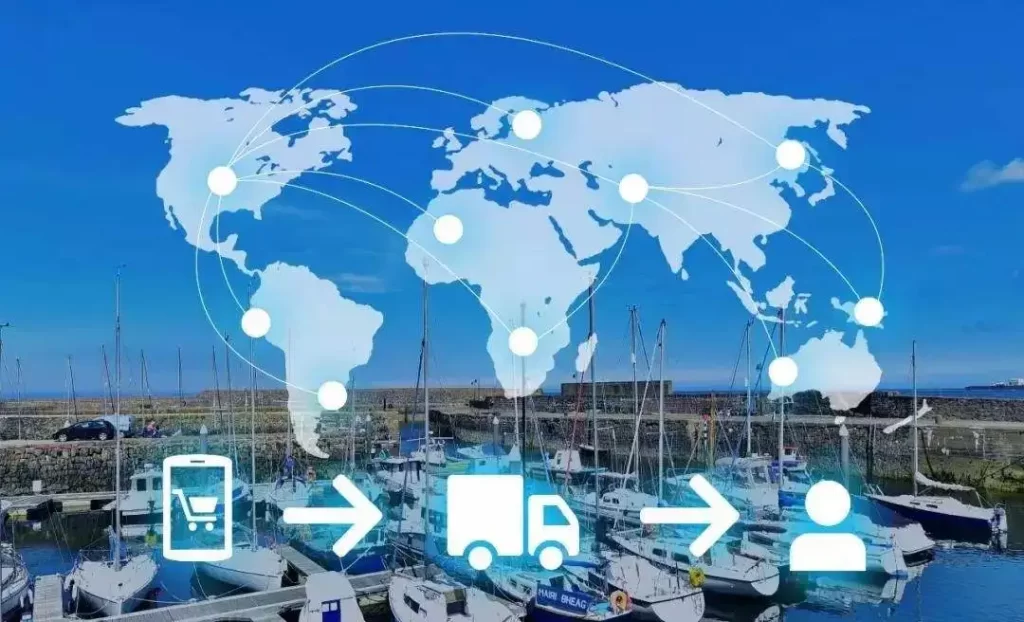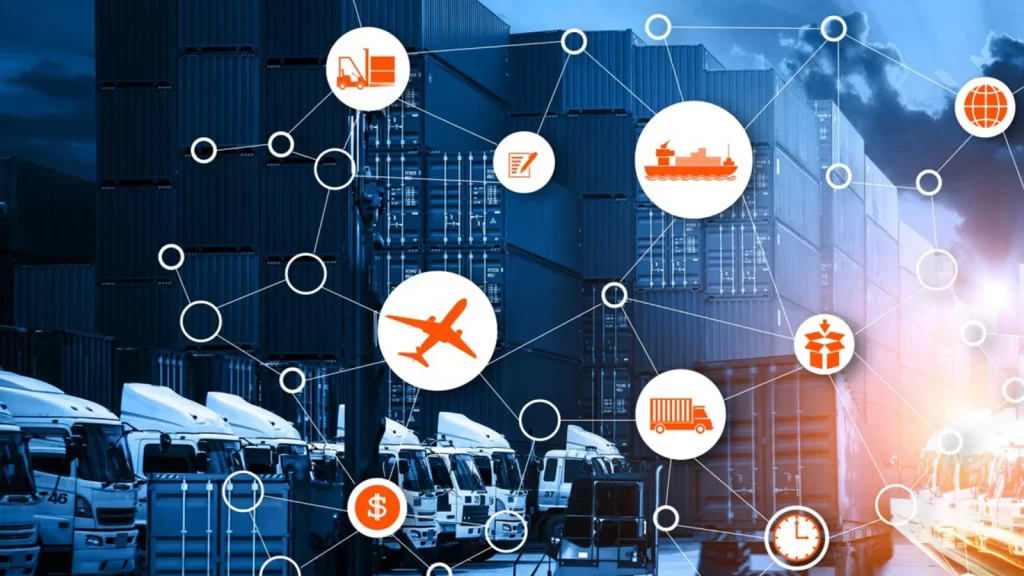Logistics is responsible for managing the flow of goods and services from the point of origin to the point of consumption; it has progressed rapidly in recent years, mainly due to the adoption of new technologies. The logistics industry is on the verge of another significant change driven by the increasing adoption of emerging technologies such as artificial intelligence (AI), Internet (IoT), and Blockchain.
The infusion of technology into logistics has become a driving force for redefining the delivery process, making it cheaper, efficient, and environmentally friendly. Looking into the future, we can see how COVID-19 has disrupted logistics business processes and how this situation has forced companies to rethink their management strategies while improving customer satisfaction. This aspect has always been critical in the industry, even when influenced by pandemic and post-pandemic challenges. This blog highlights some of the most notable technological advances in logistics that could reshape its landscape.
How Technology Can Change the Future of Logistics?

The future of logistics will be significantly impacted by technological advancements in several ways:
- When looking at the transportation landscape, particularly in road logistics, it becomes evident that numerous fleet owners own hundreds of trucks. The industry has almost 80% fragmented ownership, which means that some people own multiple trucks
- The challenge lies in the fact that these fragmented owners lack a standardized platform that allows for the optimal utilization of their services. This is where the implementation of various technologies, such as artificial intelligence (AI), big data analytics, blockchain, radio frequency identification (RFID), cloud computing, and more, becomes crucial.
- By incorporating these technologies, a platform can be established to institutionalize and professionalize logistics services by effectively connecting shippers with the appropriate transporters. Throughout the supply chain management process, there are numerous stages where technology and digitization can enhance business operations.
- These stages include production in factories, dispatch, loading, space utilization, route optimization, digitization and streamlining of documentation, payment processing, real-time telematics, end-to-end tracking, and more.
- The implementation of technology addresses many pain points within the industry and offers innovative solutions. Shortly, the logistics industry is expected to experience a significant surge in the adoption and utilization of various technologies. These advancements will bring about substantial benefits, enabling improved efficiency, streamlined processes, enhanced visibility, and greater optimization of resources.
Some major technology breakthroughs may or have already impacted the logistics industry.
Smart Fleet Management: Enhancing Efficiency and Optimization
Fleet management is a critical and complex task for logistics businesses and transportation service providers, such as taxi drivers. However, efficient fleet management is impossible without rigorous real-time data analysis, smart routing, and predictive analytics. Modern fleet management software, fueled by artificial intelligence (AI) and machine learning (ML), addresses various business challenges. This technological evolution propels the logistics industry towards enhanced efficiency, optimal resource utilization, and a comprehensive approach to managing diverse aspects of fleet operations. Typically, these applications solve a range of business problems. For example:
- Recommending optimal routes by leveraging historical and real-time data.
- Providing the flexibility for managers and drivers to reorganize routes, minimizing downtime and fuel expenses swiftly.
- Facilitating the real-time tracking of locations and drivers’ behaviors.
- Enhancing the overall user experience for clients.
Robotics Delivery: Revolutionizing Last-Mile Delivery
The post-COVID future of logistics unfolds with the integration of robotics delivery systems. After the pandemic outbreak in Wuhan, China became one of the first countries to actively utilize robotic delivery during lockdown conditions in the early stages of the pandemic. Robots are not limited to delivering pizzas but are designed to transport diverse items such as documents, clothing, pharmaceutical orders, and orders from other stores.
Similar solutions have already been implemented in hospitals across China, South Korea, and Singapore, streamlining the swift delivery of medicines from warehouses and minimizing contact between healthcare professionals.
Supply Chain Optimization and Zero Waste: Maximizing Efficiency and Sustainability
The COVID-19 pandemic has instilled a sense of frugality among companies, urging them to optimize their resource utilization. Given that the supply chain lies at the heart of the logistics business, leveraging technology for optimization becomes paramount. By augmenting the supply chain using special software, logistics companies in achieving three goals dictated by the pandemic:
- minimizing human contact by delivering to the door directly
- maximizing optimization across each element of the supply chain (integration, operations, purchasing, and distribution)
- attaining zero waste through meticulous planning of the volume of purchases (especially for perishable goods), in-depth supply and demand analysis, and improving the delivery process by fuel-efficient delivery processes by minimalizing fuel consumption and spare parts outwear.
Indeed, individual companies establish their priorities autonomously, creating bespoke logistics management systems meticulously tailored to meet their customers’ unique business needs and expectations through logistics software development.
Predictive Maintenance: Proactive Maintenance for Enhanced Efficiency
Integrating artificial intelligence and machine learning into logistics business processes is promising. Predictive analytics and maintenance are just two applications of AI and ML in logistics. However, this capability is critical for companies looking to optimize their supply chain, reduce costs, and use resources wisely.
In summary, predictive maintenance systems empower company management to plan fleet maintenance strategically and smartly. Utilizing AI-powered application aggregates comprehensive data on the technical condition of vehicles, providing timely suggestions for replacing specific parts. This proactive approach aims to prevent costly repairs, avert unexpected breakdowns, and minimize operational downtimes.
Driver Behavior Tracking: Ensuring Safety and Efficiency
Both robotic delivery and human labor in logistics pose their unique challenges. While robotic delivery requires smart management and improved cybersecurity, human-driven vehicles introduce risks and safety concerns.
A driver’s responsibility extends beyond delivering goods on time and to the correct location. They must also ensure the safety of other drivers, passengers, and pedestrians. Logistics companies, as well as those that provide delivery services, share this responsibility.
Fortunately, modern technologies enable the creation of driver behavior monitoring systems, and many companies recognize the necessity of implementing such solutions. By monitoring driver behavior, companies can identify areas of weakness and take steps to address them.
For instance, behaviors such as improper gear use, speeding, and excessive idle time contribute to fuel waste and spare part outwear. Distractions, unexpected maneuvers, and the use of drugs or alcohol are major causes of deadly accidents. Driver behavior monitoring systems help prevent these situations by informing company management about what is happening on the road.
Companies can address problematic behaviors and encourage safer driving practices by constantly monitoring driver behavior. This, in turn, results in reduced fuel usage, lower maintenance costs, and increased overall efficiency.
Driver behavior monitoring improves safety, reduces risks, and avoids accidents and incidents. It allows logistics companies to foster a culture of responsibility and enhance the performance of their fleets.
Drones and Self-Driving Vehicles: The Future of Delivery
While self-driving cars remain a vision for the future of the automotive industry, drones are already making their mark in logistics. Companies like Stock Logistics utilize drones for their warehouse management, and major retailers, including Walmart, are conducting the first tests for product delivery via drones. Despite ongoing debates surrounding drones as a technology in terms of control and security, the pandemic has prompted companies to look more closely at these innovations. Even though there are some countries (they are primarily countries whose governments strictly control access to information), drones represent a promising addition to the logistics toolkit, offering efficient and timely deliveries.
Improved Cybersecurity Systems: Protecting Data and Ensuring Safety
As artificial intelligence, machine learning, and the Internet of Things become integral to logistics business processes, generating massive data flows daily becomes inevitable. Naturally, some of this data will be vulnerable, especially when we talk about robotic delivery, drones, and self-driving vehicles.
Even a minor technological vulnerability within these systems could lead to undesirable and potentially tragic consequences, such as if intruders take over the control of a self-driving machine.
Consequently, the future of the logistics business is intrinsically linked to enhancing existing security standards, developing new protocols, and heightening business owners’ responsibility to customers, drivers, and society.
Conclusion
The future of the logistics sector unfolds as a data- and technology-driven landscape. Many technologies in use today were developed before the COVID-19 pandemic, yet businesses have adapted, improving services and customer experiences through logistics technology and intelligent management. The worldwide challenge for logistics is to construct secure and sustainable business processes while leveraging technology to create a greener, more ethical, healthier, and safer industry. Embracing these technology breakthroughs guarantees that the logistics business remains on the cutting edge of innovation, addressing the constantly evolving requirements of a fast-changing globe.
FAQ’s – Frequently Asked Questions
1. How does technology influence the future of logistics?
Technology is causing significant disruptions in the logistics industry. AI, IoT, blockchain, and automation improve operations, supply chains, analytics, and process efficiencies. It’s all about making logistics quicker, more stable, dependable, and cost-effective.
2. What advantages does technology provide to the logistics industry?
Consider this: real-time tracking for shipments, boosted supply chain visibility, super-tuned inventory management, automation cutting out manual headaches, top-notch route planning, and fewer errors. It’s a solution for ramped-up efficiency, satisfied customer experiences, lower costs, and logistics companies being on the top among the competition.
3. How’s AI changing the logistics industry?
AI integration is a game changer in logistics. Smart algorithms dig through massive databases to optimize supply chains, estimate demand, fine-tune routes, and automate choices. Predictive analytics implies preventive maintenance, less downtime, and a more efficient overall logistics operation.
4. What benefits can blockchain technology provide the logistics industry?
Blockchain provides transparency, security, and traceability to improve logistical operations. Consider tamper-proof transaction records, building trust, and keeping things authentic in the supply chain. It’s also streamlining document exchange, excluding middlemen, reducing fraud, and making cross-border transactions easy. All in all, it’s about making logistics efficient, trustworthy, and budget-friendly.
5. How’s the logistics world changing with autonomous vehicles and drones?
Autonomous vehicles and drones are turning logistics upside down. AI-backed vehicles optimize routes, reduce delivery times, and increase safety with advanced sensors. Drones? They deliver packages to far-off or crowded spots, making last-mile deliveries fast and flexible. It’s a speed boost, efficiency upgrade, and accessibility overhaul in logistics – a real game-changer for moving and delivering goods.

